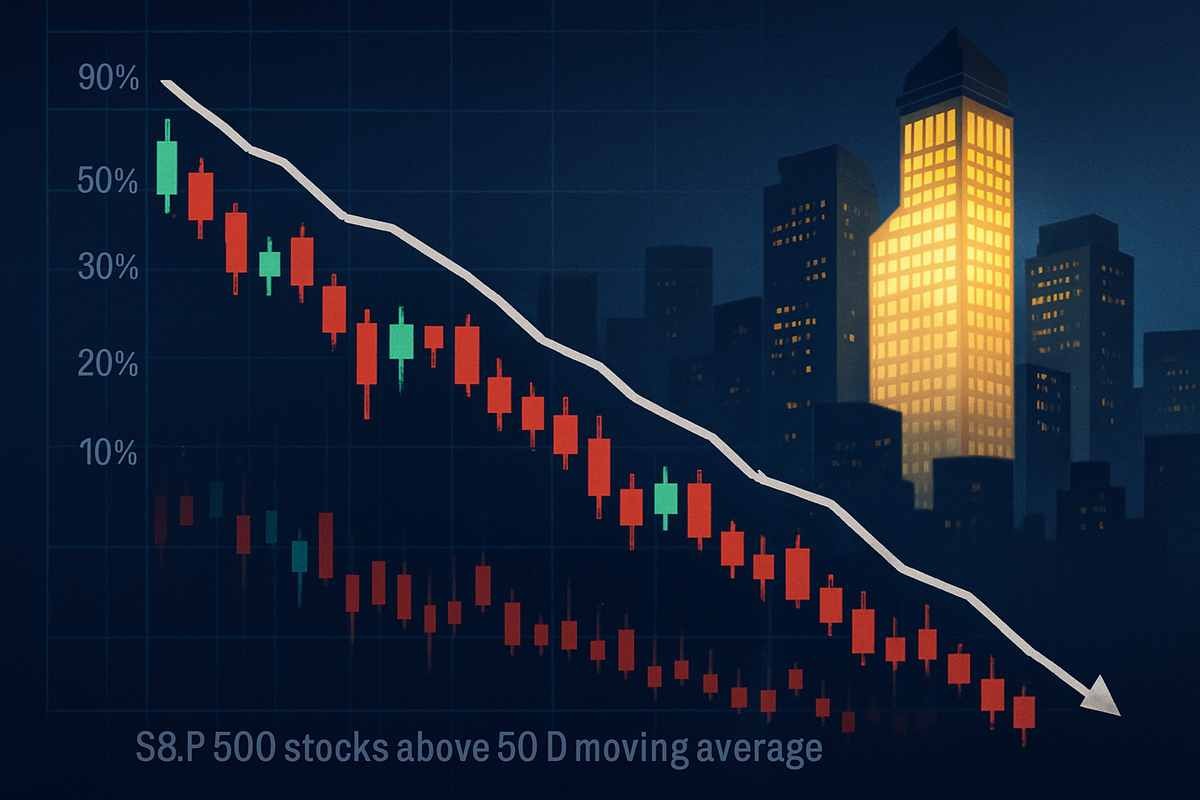
Wall Street is grappling with an increasingly narrow market rally, as concerns about market breadth intensify. A significant slide in the percentage of S&P 500 stocks trading above their 50-day moving averages signals that the market's upward momentum is increasingly reliant on a select few heavily capitalized companies. This concentration raises questions about the sustainability and overall health of the current bull run, prompting caution among investors and analysts alike.
The divergence between headline index gains and underlying market participation suggests a potential loss of steam. While major indices continue to flirt with record highs, the dwindling number of stocks contributing to these gains indicates a fragile foundation. This phenomenon, often termed "bad breadth," historically precedes periods of increased volatility or corrections, making it a critical indicator for market watchers.
The Narrowing Path: What Happened and Why It Matters
The recent slide in market breadth has been stark. In late July 2025, approximately 75% of S&P 500 stocks were trading above their 50-day moving averages, a key indicator of short-to-medium term bullish momentum. By early August 2025, this figure had plummeted to barely 50%. This steep decline underscores a significant narrowing of the market rally, where fewer individual stocks are participating in the upward movement. Further compounding these concerns, the S&P 500's advance-decline line, another crucial breadth measure, has been in decline since May 2024, even as the S&P 500 index itself has soared to record highs. This divergence paints a picture of an erosion of sentiment in the broader equities market, masked by the performance of a select few.
This trend is not entirely new, having been a recurring theme throughout 2023 and intensifying into 2024 and 2025. The primary drivers of the S&P 500's performance have been a handful of mega-cap technology companies, often referred to as the "Magnificent Seven." These include Apple (NASDAQ: AAPL), Microsoft (NASDAQ: MSFT), NVIDIA (NASDAQ: NVDA), Amazon (NASDAQ: AMZN), Alphabet (NASDAQ: GOOGL), Meta Platforms (NASDAQ: META), and Tesla (NASDAQ: TSLA). Due to their immense market capitalizations, these companies, particularly those heavily involved in artificial intelligence (AI), have an outsized effect on the S&P 500's performance. For instance, in June 2023, the top five largest stocks in the S&P 500 accounted for over 24% of the entire index, a five-decade high. As of June 9, 2025, the Magnificent Seven stocks were up by an average of 31.7% from April 8, while the S&P 500's gain would be significantly lower (16.9%) if these seven stocks were excluded. The Information Technology sector was notably the only sector to have outpaced the S&P 500 in June 2024.
Initial market reactions to these breadth concerns have been mixed. While the S&P 500 has continued to hit record highs, analysts and strategists have voiced increasing caution. Some describe the rally as "not healthy" due to the lack of broad participation. The divergence between the S&P 500 and its underlying breadth indicators has raised alarms on Wall Street, leading to increased market volatility and a recalibration of investor sentiment.
Winners and Losers in a Concentrated Market
In this environment of narrowing market breadth, the "winners" are unequivocally the mega-cap technology companies, particularly those at the forefront of the AI revolution. Companies like NVIDIA (NASDAQ: NVDA), Microsoft (NASDAQ: MSFT), and Apple (NASDAQ: AAPL) continue to attract significant capital, driving their valuations higher and, by extension, propping up the overall S&P 500 index. Their robust earnings and future growth prospects, especially in AI, make them attractive to investors seeking growth in a challenging economic landscape. The Information Technology sector, fueled by these giants, has consistently outperformed the broader market, becoming the primary engine of the current rally.
Conversely, the "losers" are the vast majority of S&P 500 stocks that are not participating in this concentrated rally. This includes a wide array of companies across various sectors, particularly small-cap and mid-cap stocks, which are struggling to gain traction. These companies, despite potentially solid fundamentals, are being overshadowed by the outsized performance of the market leaders. For investors, this creates a significant challenge: while the headline S&P 500 index may appear strong, a diversified portfolio that includes these underperforming stocks may not be yielding comparable returns.
The implications for these companies are profound. For the market leaders, continued inflows of capital could lead to further valuation increases, but also expose them to greater risk if their growth narratives falter. For the broader market, the lack of participation means a more challenging environment for capital raising and investor interest. This increased concentration risk also affects passive investors, whose portfolios become heavily weighted towards a few companies, potentially reducing the diversification benefits typically associated with broad market index funds. A sharp decline in the shares of these largest companies can have an outsized impact on the entire index, making the broader market vulnerable to significant corrections.
Industry Impact and Broader Implications
The current market breadth concerns fit into broader industry trends, most notably the accelerating dominance of technology and artificial intelligence. This era is characterized by a winner-take-all dynamic, where a few innovative companies capture a disproportionate share of market value. This trend is further amplified by the rise of passive investing, where capital flows into broad market indices, inadvertently concentrating wealth in the largest constituents. The increasing market capitalization of the "Magnificent Seven" has created a feedback loop, where their growth attracts more investment, further solidifying their market dominance.
The potential ripple effects on competitors and partners are significant. Companies that are direct competitors to the "Magnificent Seven" face an increasingly challenging environment, as they struggle to compete with the scale, resources, and innovation of these giants. Conversely, partners or suppliers to these dominant tech firms may see benefits, but their fortunes remain tied to the success of a concentrated few. This dynamic could lead to further consolidation within industries, as smaller players struggle to keep pace.
From a regulatory standpoint, while not explicitly stated in the research, the increasing market concentration could eventually draw greater scrutiny regarding anti-trust concerns and market power. Policymakers may begin to examine whether such concentration stifles competition and innovation in the long run. Historically, sharp declines in market breadth have often signaled below-average returns and larger-than-average drawdowns ahead. While narrow markets don't always lead to a collapse, they often precede periods where the market either "catches down" (leaders decline) or "catches up" (laggards rise), indicating a rebalancing of market forces. This historical precedent serves as a cautionary tale, suggesting that the current rally, while impressive on the surface, may be built on a less stable foundation than a broad-based advance.
What Comes Next
Looking ahead, the market faces a critical juncture. In the short term, continued volatility is likely as investors weigh the strong performance of a few mega-cap stocks against the underlying weakness in broader market participation. A near-term pullback remains a distinct possibility if the divergence in market breadth persists or worsens. The market's resilience in shrugging off external issues and focusing on company fundamentals, particularly in mid-2025, has been observed, but this resilience may be tested if the concentration risk becomes too pronounced.
In the long term, two primary scenarios could unfold. The market could experience a "catch down," where the leading mega-cap stocks correct, bringing the overall index down. Alternatively, a "catch up" scenario could emerge, where the broader market eventually widens, and the laggards begin to participate in the rally, leading to a healthier, more sustainable advance. Investors may need to consider strategic pivots, potentially re-evaluating their diversification strategies and perhaps favoring active management over passive approaches to identify opportunities in undervalued segments of the market.
Market opportunities may emerge in those broader market segments that have been overlooked, should breadth eventually widen. However, navigating a highly concentrated market presents significant challenges, requiring careful analysis beyond headline index numbers. The coming months will be crucial in determining whether the current narrow rally can broaden out or if it will eventually succumb to the pressures of its own concentration.
Conclusion
The emerging concerns about market breadth represent a significant development in the current financial landscape. The recent slide in the percentage of S&P 500 stocks trading above their 50-day moving averages, coupled with the outsized influence of a few heavily capitalized technology companies, highlights a market rally that is increasingly concentrated and potentially unsustainable. While the "Magnificent Seven" continue to drive headline gains, the lack of broad participation raises questions about the underlying health and resilience of the market.
Moving forward, the market stands at a crossroads, balancing the robust earnings and AI optimism from tech giants with the inherent vulnerability posed by narrow market breadth. This trend underscores the evolving dynamics of market leadership and the importance of looking beyond headline index numbers to assess true market health. Investors should remain vigilant, closely monitoring breadth indicators, the performance of the leading mega-cap stocks, and any signs of broader market participation. The coming months will reveal whether the market can broaden its base for a more sustainable rally or if the current concentration will lead to a period of increased volatility and potential correction. The lasting impact of this period will likely be a re-evaluation of diversification strategies and a renewed focus on fundamental analysis across the entire market spectrum.





